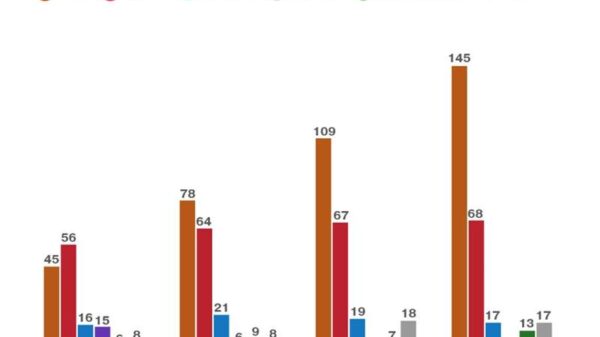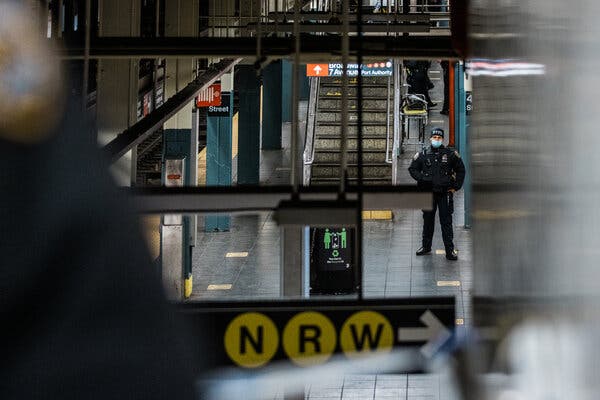A fire in the Bronx choked an apartment building with thick black smoke, killing 17 people, many of them children. That was on the ninth day of January, a Sunday — the same day a teenage cashier at a Burger King in Manhattan was shot and killed during a robbery.
The following Saturday, a man killed a woman he’d never seen before by shoving her in front of an oncoming subway train in Times Square, a crime that uniquely horrifies New Yorkers, unpreventable and random as lightning.
Three days later, on Tuesday, an officer in the Bronx was shot in the leg during a struggle. Wednesday: a baby was shot in the face by a random bullet while sitting in a parked car in the Bronx. Thursday: a detective shot, this time during a drug arrest in Staten Island.
And on Friday, two officers responding to a domestic dispute in Harlem were shot in an apartment hallway by a man with a stolen gun, killing one and leaving the other clinging to life.
All these incidents played out in a city still staggering from the coronavirus and grappling with its Omicron variant, which has kept the empty storefronts empty and delayed indefinitely the return of office workers and a sense of normalcy.
The march of terrible news has felt dizzying, leaving many to question the very soundness of the city beneath their feet — their home, a place that, for many, has felt unfamiliar of late. In dozens of interviews around the city this weekend, New Yorkers young and old, lifers and newcomers, described a new and deep unease at what looks like an erosion of social norms and the sense of security that they remember before the pandemic.
“It feels like it’s getting worse, and I don’t know what they’re going to do to straighten it out,” said Michael Marcus, a barber trimming a customer’s beard in Harlem, just a block from that fatal shooting of the officer. “They have to think of something.”
At age 54, Mr. Marcus is old enough to remember hard times in the city, like the crack wars that led to thousands of murders a year. While it is true that shootings and homicides have increased since 2018, they remain a fraction of bad-old-days New York. In 2021, there were 488 homicides, compared with 2,262 at their peak in 1990 after a decade-long stretch near or above 2,000.
But what Mr. Marcus sees today worries him. “Things happened in the ’90s, but not like this,” he said. “Now a lot of people are dying a lot of different ways. You’ve got coronavirus, you’ve got the shootings, you’ve got the stabbings, you’ve got people being pushed onto train tracks. Right now, I don’t feel like it’s going to get better. And if it does, it’s going to take a while.”
In Corona, Queens, Amadou N’gom, 22, said his work as an Uber driver has given him a picture-window view of the uncertain state of the city. “We’re in this rocking boat on the ocean,” he said. “We can make it work, but if another big tsunami comes, it’s going to hit all of us.”
But he has faith: “New Yorkers will prevail in their persevering attitude.”
Not everyone seems so sure. In Flushing Meadows Corona Park in Queens, beside a frigid Meadow Lake near the site of the World’s Fair in 1939 and 1964 — proud displays of urban might before the entire globe — Eliza Xu, 50, stood and sighed. A nail salon employee out of work since the pandemic began, her dismay runs from the cost of scallions in her grocery to the malaise that has washed the colors out of her daily life.
“No hope,” she said. “No parties, people don’t need to buy nice clothes, no makeup. Life is too boring, it’s tiring. We’re still not finished, still in the pandemic.” And then came the death of the woman pushed before the train, who was Asian American, a group singled out for hate crimes during the pandemic. “I’m afraid because I’m Asian,” she said. “We don’t go out at night, we don’t take the subway — what can we do? No hope, just living.”
In Prospect Lefferts Gardens in Brooklyn, Carson Gross, 37, recognizes that unease and blames much of it on the pandemic. “People have been locked down for so long that they’ve lost social skills,” he said. “Little things, where you could just say ‘sorry’ or ‘excuse me,’ could turn into a fistfight sometimes. It just feels like everybody’s really on edge.”
At McCarren Park in Brooklyn, two friends, Beverly Bryan and Tatiana Tenreyro, said recent weeks have tested their optimism.
“We’re all trying to convince ourselves that there’s hope, but we’re all realistic enough to know that things are not good,” said Ms. Tenreyro, 27, a writer.
Ms. Bryan, 41, also a writer, wondered when optimism turns into something closer to delusion. “New York is tough, but sometimes that’s a flaw,” she said. “With everything that happened, what would constitute a breaking point?”
Her friend turned to her. “Isn’t it awful that we just expect all these awful things to happen?” Ms. Tenreyro asked. “It’s like we’re just used to it.”
“It’s kind of like the frog boiling,” Ms. Bryan replied.
Janet Miller, 81, a retired attorney and lifelong New Yorker, said recent events reminded her — like many others in the past weeks — of a specific era.
“It seemed to me it was going back to the ’70s,” she said as she walked her schnauzer, Murphy, around Stuyvesant Town in Manhattan. “All the gun violence.” Nearby, 60-year-old John Cuban said he misses a sense of security he had felt in recent years.
“When I was younger I used to go to the city all the time, and I had no fear, no fear to ride the subway,” he said. “Now I have anxiety, it scares me about the subway.”
In truth, the 1970s were a demonstrably more perilous time for New York City, as borne out by numbers. Back then, an exodus of employers and taxpayers compounded the city’s budget woes, pushing it to the brink of bankruptcy. With no way to bridge the fiscal gap in sight, the state took control of the city’s finances.
Public employee unions were forced to agree to steep job cuts. Big corporations, including General Electric and PepsiCo, moved their headquarters to the suburbs. In 1975, the city’s unemployment rate hit 12 percent, well above the national rate of about 8.5 percent.
“And then the city recovered,” said Richard Ravitch, who is widely credited with helping that recovery come about. He was named the head of the New York State Urban Development Corporation when it was nearly insolvent in 1975 and, later, chair of the Metropolitan Transportation Authority. He would become the go-to official during difficult times.
Mr. Ravitch is now 88, and what he sees today outside his Upper East Side home and office on East 51st Street feels much different.
“It’s hard for me to find a restaurant in the neighborhood to go to for lunch, all the hotels in that neighborhood are closed and the office buildings are dark,” he said. “A lot of people are working from home because of the technology available and want to isolate because of the virus, and I think a lot of people have moved, to Florida or the suburbs. It’s causing a devastation to the New York City economy.”
Don’t try comparing today with the 1970s in front of Mary Garvey, 62, a retired schoolteacher. Not even close.
“In the big, bad days I had knives pulled on me, I had guns held on me,” she said. “As a young woman in the ’80s, holy crap. I had men grab every part of my body on the street. I know what bad looks like, and this is not the same.”
She is a lifetime New Yorker. “I called the police every night about hearing gunshots in Park Slope,” she said. “There was open drug-dealing on the streets. You could buy drugs at the local bodega.”
In the Bronx near Yankee Stadium, a Navy veteran and Baptist deacon, Rodney Anderson, 52, remembers those bad years less colorfully but no less vividly, and sees better days ahead.
“I’m not afraid, I don’t live in fear,” he said. “The city and the country are going through a cycle, and that’s how life is. It’s got to get better. It has to. It always gets better.”
Getting things better was practically the job description for Mr. Ravitch, the former city official, who spoke Sunday by telephone from his apartment over a recording of “Aida” playing in another room. “People want to go to Yankee Stadium or the concert halls,” he said. “I’m an opera fan, as you can hear.”
He said that on a recent walk up Madison Avenue, he was dismayed by many empty storefronts, but he saw plenty of new stores, too.
“I think cities are the most important socializing institution that we ever created,” he said. “I think young people want to be able to have a drink at the end of the day, meet a girl or a boy. It’s going to come back.”
Ana Ley and Patrick McGeehan contributed reporting.































